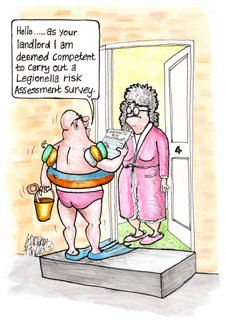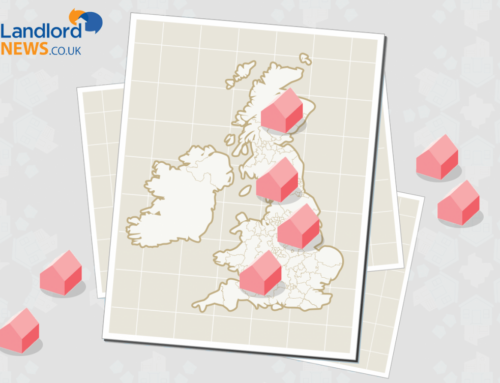This article is an external press release originally published on the Landlord News website, which has now been migrated to the Just Landlords blog.
Here at Landlord News, we are committed to giving our readers advice on how best to avoid and manage risks from Legionella and Legionnaires’ disease.
Information included in this guide will cover features such as identifying the disease, who is responsible for managing certain premises and understanding duties to comply with health and safety legislation.
There are a number of risks to exposure to Legionella within workplaces, homes and public places. With the correct guidance, we can work together to reduce risks to ensure that we all contribute to minimizing or eradicating the threat of the disease.
What is Legionnaires disease?
Legionella bacteria can cause a number of diseases, known collectively as Legionellosis. The most serious conditions caused by this bacteria is Legionnaire’s disease. This is a potentially life-ending form of pneumonia with everybody at risk of infection. Susceptibility to the infection increases with age, with smokers, heavy drinkers and people with diabetes or an impaired immune system more vulnerable.
Where it comes from
The bacterium that causes the infection, Legionella pneumophila are widespread in natural water sources, such as rivers, ponds and lakes. However, it is normally only found in low numbers in these areas and conditions are usually not conducive enough for it to be harmful to humans.
More commonly, the infection is likely to cause illness when found in purpose-built water systems, such as cooling towers, hot and cold water appliances and spa or swimming pools. Favourable conditions, where temperature is kept high enough for the bacteria to spread, can lead to increased risk of infection or in extreme cases, fatalities.
How can people catch it?
People catch Legionnaires’ disease by inhaling aerosols (small droplets of water) that contain the harmful bacteria. Conditions conducive to the spreading of the disease are water systems with a temperature between 20-45% degrees and anywhere water is re-circulated. Additionally, risk of legionella is increased where there are deposits for bacterial growth to be supported by a source of nutrients, such as rust, organic matter and sledge.
Risks in the workplace
Any water systems, exposed to the right conditions, could be a breeding ground for legionella bacteria. The most common risk in the workplace include but are not limited to:
- water-coolers
- humidifiers
- air washers
- showers
- water fountains
- cooling towers
Risk assessments
It is the duty of the employer or someone in legal control of the premises, ie a landlord or agent, to not only understand but also manage the risk of legionella. All systems must be subjected a risk assessment. These need not always be anything elaborate and will hopefully show that risks of contracting the disease is low and is already being sufficiently managed. However, these assessments must be reviewed on a regularly basis.
Under the Health and Safety at Work Act 1974, duties were extended to make it a legal responsibility for employers to tackle risks from legionella bacteria that could arise from work-based responsibilities.
Moreover, the Control of Substances Hazardous to Health Regulations 2002 (COSHH) gives a set of actions intended to identify, prevent or control risks of bacteria such as Legionella. Efficient precautions must then be undertaken.
Thorough advice on dealing with the threat of these risks can be found in The Approved Code of Practice: Legionnaires’ disease: The control of Legionella bacteria in water systems.
Responsibilities
The employer or person in control of a property is legally obliged for the upkeep and implementation of health and safety measures. This means that it is the role of the responsible person to reduce and manage risks of exposure to legionella.
The responsible person is required to:
- identify and assess the main sources of risk of legionella
- manage any identified risk
- control or prevent this risk
- keep up to date records
- continue to carry out other duties
Identifying risks
Carrying out a risk assessment is the duty of the responsible person. Advice must be sought from outside sources if this person feels that they cannot individually manage the assessment.
It is the duty of the person managing the risks to understand all water systems in the property and the equipment relating to them, such as pumps and heat exchangers. Then, the constituent parts must be assessed and if they pose a threat to exposure from legionella must be managed accordingly.
Alongside taking into account features such as the water temperature and the surrounding conditions, susceptibility of employees, residents or visitors must be taken into account. Illness, weak immune systems and direct exposure to contaminated water should all be considered.
All risk assessments should include:
- full management responsibilities, which should include the name of the competent person and a full description of each system
- details of the competence and qualifications of key personnel
- all risks identified
- means of preventing or controlling the risk
- inspection and ongoing monitoring procedures
- keeping records of all inspections and checks
- overseeing and planning arrangements to continue with regular assessments
If a satisfactory outcome is reached following a risk assessment, ie there is no forseeable or immediate risk and a sufficient system is in place, then the assessment is complete. No further action is necessary, but controls must be continued and all assessments reviewed on a regular basis.
Managing risks
An employer or person controlling a premises is responsible for appointing somebody competent in order to assist them with health and safety duties. They then accrue responsibility for controlling an identified risk of legionella bacteria. The competent person is otherwise known as the responsible person and is a someone with substantial authority, competence, relevant skills, knowledge and experience. An appointed responsible person is one or a combination of:
- the employer or owner premises owner
- one or more employees
- a third party contact
In cases where several people are responsible for managing risks, for example because of a shift pattern, all competent persons must be aware of their duties. Where contractors are employed to assist with features such as water treatment, it is still the responsibility of the responsible person to ensure that any action is carried out in a suitable manner.
Prevention
As an initial measure, the responsible person(s) must consider if the risk of legionella can be prevented. This could be as simple as changing a wet cooling tower with a dry air-cooled system. The ultimate goal is to design, control and efficiently operate water systems in an environment that either prevents or substantially eases the growth of legionella bacterium.
If a risk is identified which proves unable to prevent, a course of action must be provided in order to assist in managing the risk of legionella moving forwards.
A written control scheme must describe:
- the system being assessed
- the responsible persons carrying out the check
- how the system safely operates
- what control methods are planned to be used
- how further checks for legionella risks will be carried out
As a general checklist, competent persons must:
- ensure water release spray is efficiently controlled
- avoid temperatures that favour the growth and spread of legionella and other bacteria
- make sure that water is not able to stagnate in the system by keeping pipe lengths short
- avoid the use of materials that are conducive to the growth of legionella. Where possible, use the recommended materials listed in the Water Fittings & Materials Directory
- clean the systems regularly
- monitor control measures introduced
Recording
Employers with five or more employees must record all significant findings from their assessments. In particular, the most severe risks, along with the measures taken to prevent or control these, must be recorded.
These records should include:
- the person(s) conducting the assessment
- findings from the assessment
- details of the implementation of a written control scheme
- operational statistics of the system in question
- results of any previous tests, with the date they were carried out
Additionally, under the Notification of Cooling Towers and Evaporative Condensers Regulations 1992, the responsible person must notify their local council in writing if there is a cooling tower or evaporative condenser on site. Details of the device should include where it is located, the date on which it was first used and if it is still in regular usage.
Under the Reporting of Injuries, Diseases and Dangerous Occurrences Regulations (RIDDOR), the competent person must report any case of legionellosis in an employee. This is particularly important for employees who have been working on cooling towers or hot and cold systems that are likely to be contaminated.
Symptoms and Treatment for Legionnaires’
Symptoms associated with Legionnaires’ disease are very similar to those experienced by someone who has the flu. Typical symptoms include:
- high temperatures
- coughing
- muscular pains
- headache
- diarrhoea
- mental confusions
Legionnaires’ disease can be treated with an antibiotic, usually erythromycin or similar. The disease is not known to spread between persons.
More useful information can be found at the HSE website.
Landlord News would like to thank Graham Fowell, ‘The Hit Man,’ for kindly providing the illustration for the article. More of Graham’s work can be found at www.caricaturesandcartoons.co.uk





